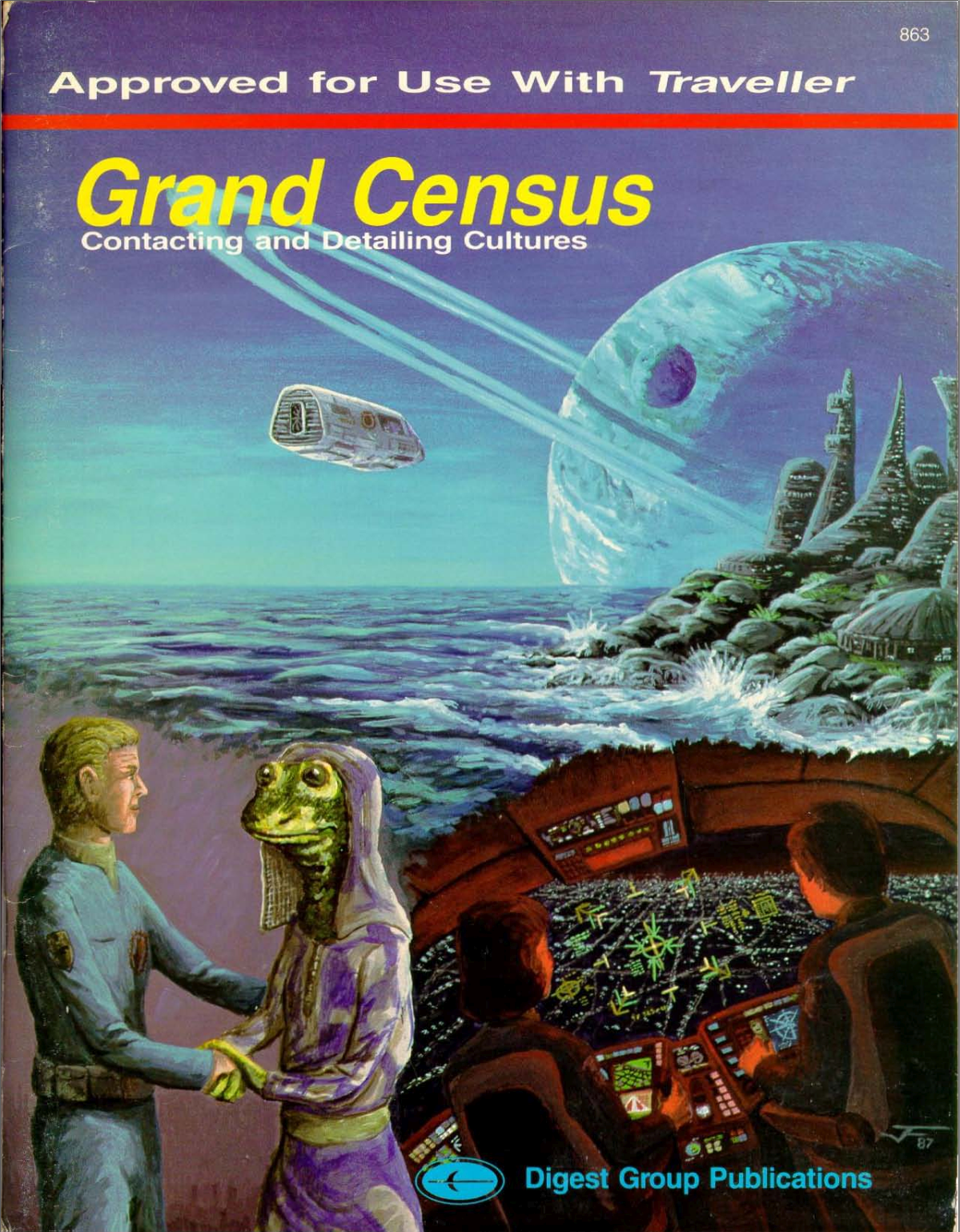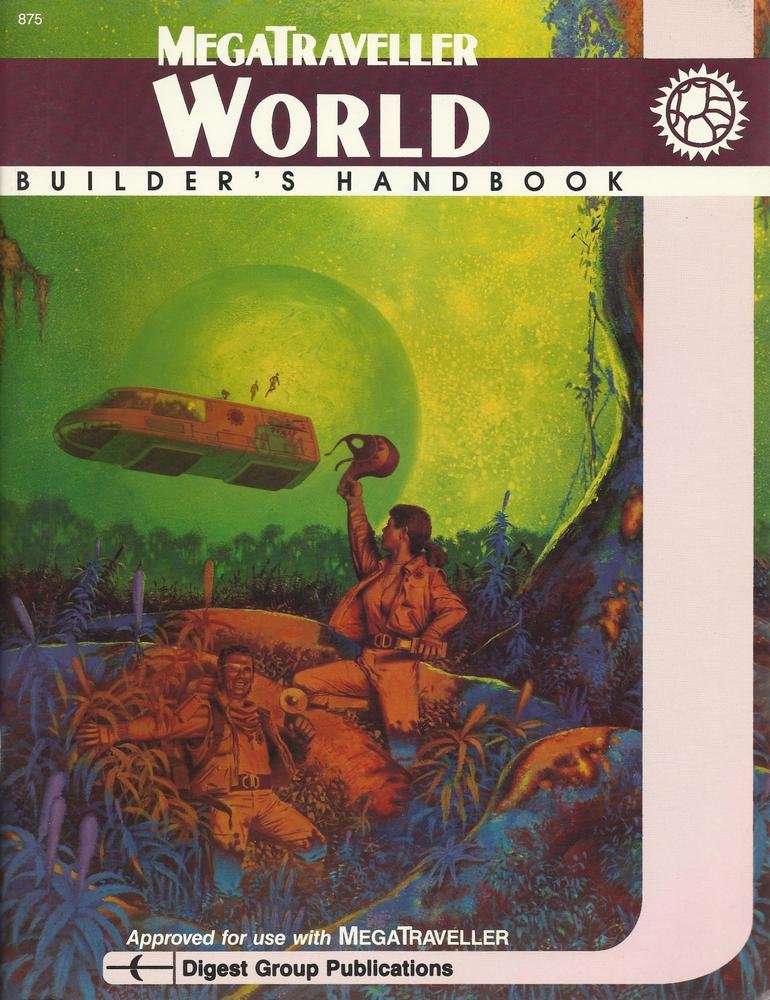DGP World-Building Supplements
This article originally appeared in the May/June 2025 issue.
Grand Survey (GS), Grand
Census (GC), World
Builders’ Handbook (WBH). Multiple Authors.
Digest Group Publications (defunct, no website)
Softbound, 48 (GS, GC) or 96 (WBH) pp.
Price varies (very high) on second-hand market
Digest Group Publications was an authorized third-party publisher for Traveller and MegaTraveller. Most of their supplements were considered high-quality, and were often sought after subsequent to DGP’s exiting the Traveller market as a result of philosophical disagreement with the direction that Traveller was going. This more-or-less continues to be the case, at least among old Traveller hands, and has led to prices climbing into three digits for any of these supplements.
The three supplements reviewed here represent DGP’s efforts to expand on world and system building, even beyond what Book 6: Scouts offered. Obviously, you need a set of basic Traveller rules, and Book 6: Scouts is going to be helpful (thought not strictly essential) as well.

Grand Survey
When you roll up a world using Book 3: Worlds and Adventures, you get basic information about a world, but very little, if anything, to inspire you in bringing the world to life. Book 6: Scouts offered some expansion of this, but it was essentially detailing the system, not the world – you’d find out that the mainworld was a satellite of the large Gas Giant in the habitable zone of the F8 star, but you wouldn’t find out that there were eight medium-sized continents and a triple-handful of major islands, or that the tainted atmosphere was so considered because of high sulfur dioxide emissions from having lots of vulcanism. Grand Survey fills the gap, and then some. This was one of the early books with the wonderful “DGP task system” that eventually became the “root” of most Traveller task systems subsequently, and it presents every task that might arise in a planetary survey using the rules presented here. You also get a selection of equipment that would be used in such surveys, along with the usual cost information and tasks for using them. All this is nearly the entire first half of the book.
The referee who wants to know more about the world that the adventure is going to take place on should turn to the second half of this guide. Here will be found the procedures and formulae that will change the world from a few digits of UWP to one with a defined gravity, oceanic currents, climate bands, temperature data, tectonic plates, likely resources, and even a map with continents and islands placed in a not-unrealistic manner.
While it’s not absolutely required, the process for detailing a world is definitely biased toward using Book 6: Scouts to lay out the system and determine things like stellar type and planetary orbital radius. Often, you’re told to make arbitrary decisions on base factors if you’re not using Book 6: Scouts, which can give you some improbable results if you aren’t making an effort to pick numbers that have some grounding in reality.
Grand Survey focuses on the physical stats of the world, although it touches on the Population digit enough to suggest the number and placement of conurbations on the world’s surface. But that’s only half of the job of detailing a world. For the rest, it’s time to look at Grand Census.

Grand Census
Where Grand Survey focused on detailing the world itself, Grand Census focuses on detailing the culture or cultures that may be found living there. As with Grand Survey, the first half of the folio provides procedures and equipment relevant to the job of defining a culture from the point of view of a survey – the first-contact scenario, for example. There’s less detail about procedure here, because there’s far more variability in how the survey PC and the contacted sophonts will react to each other than there is in determining the physical parameters of a world.
Although Grand Survey and Grand Census are usually discussed as a pair, neither depends on having worked your way through the other – you can detail a culture using Grand Census based only on the UWP generated by the basic Traveller rules, and there are no dependencies on culture in Grand Survey. That doesn’t mean that the information from Grand Survey won’t be useful when detailing a culture through Grand Census – the physical environment can certainly at least provide inspiration for influences on culture.
“Culture”, for the purposes of Grand Census, doesn’t refer only to the ‘exotic’ things you’ll see if you venture into one of the ‘foreign’ quarters of a major city on a cosmopolitan world (like ‘native’ foods or clothing); it also covers things like how a world – or a nation on a balkanized world – structures its government (including which arm of the government gives the world its UWP Government code), how strict the law is in various aspects of society (criminal law, trade law, contract law, and so on) and how rigorously the law is actually enforced (and whether that enforcement is equal for all offenders), what are local attitudes toward outworlders, toward social change, and so on; what local technology development and availability is; specific noteworthy local customs, habits, or peculiarities (and whether they might apply to – or be specifically forbidden to – outworlders); and so on.
Religion can be a sensitive subject for a gaming group, so it’s not unusual for it to be ignored completely. However, it really can’t be denied that religion has been a significant factor in history and in cultural development. Referees who wish to acknowledge this will find some rules for creating (in broad) the outline of a religion, which can then be used as an influence on the culture that is being developed from the rest of Grand Census.
The end result of the referee’s work with Grand Census shouldn’t itself be considered a usable culture; rather, it’s a bunch of information that the referee can use as an ‘outline’ of the culture, perhaps as a basis to compose questions and answers for a process similar to what Jeff Zeitlin outlined in his “Building a Culture”. It will very definitely take a liberal dose of imagination to round it out and make it coherent.

World Builders’ Handbook
This volume is a consolidated and somewhat reorganized version of Grand Survey and Grand Census, with some updates to accommodate the changes between Classic Traveller and MegaTraveller, and some expansion to handle detailing that was present in Book 6: Scouts, but which didn’t carry over into the MegaTraveller Referee’s Manual. It is intended to be used to supplement the MegaTraveller Referee’s Manual (which provides the basic UWP generation procedure and the equivalent of most of the Book 6: Scouts extended system generation), but it doesn’t appear to refer back to it, so if you have a MegaTraveller-compatible UWP from any source, you should have no trouble using this volume to detail the world.
This volume seems to contain more information about more survey equipment than Grand Survey; in some ways, the presentation here is better. Worksheets representing displays and control consoles are often clearer, and some appear to have been simplified. Many pieces of equipment that have limits on use (for example time or charges) allow for that use to be tracked in play right on the worksheet.
The organization of this volume appears to assume that one will detail both physical and population details for a world, in that order. The division between the two is definitely not as clear as between Grand Survey and Grand Census (which were, after all, separate products). It doesn’t appear that anything present in Grand Survey/Grand Census has actually been omitted from World Builders’ Handbook, though some of the explanation may be shorter and less detailed, and World Builders’ Handbook does add material on detailing Gas Giants and asteroid/planetoid belts, two aspects of system detailing that Grand Survey omitted.
Final Comments
What you’ll get from using the procedures outlined in Grand Survey or World Builders’ Handbook is a system that will look more like the Sol system than it will most presently-known exosystems. That shouldn’t be taken as a flaw; rather, it represents the state of knowledge at the time they were written, when we had a sample size of one, and no reason to think that Sol was an atypical system. That doesn’t mean that you shouldn’t go ahead and use these procedures and results; it just means that you need to manage your expectations accordingly – there is no question that the results you get will fit into a Traveller universe nicely.
Unfortunately, these haven’t become available from FarFuture or Mongoose via CD-ROM or DTRPG; your only hope of acquiring them would be print copies on the second-hand market – and I’ve seen asking prices well over $100 for any of them. Even if I were using Classic Traveller, I think I’d prefer to have World Builders’ Handbook, because it provides slightly more focus on actually playing the survey as part of your game, and because it provides for detailing parts of the system ignored by Grand Survey. Because of the high price point, I really can’t recommend any of these as specific targets for acquisition, but if you do manage to acquire them for a price you find acceptable, and in usable condition, you’ll definitely have some good world-building tools in your kit.
 Freelance
Traveller
Freelance
Traveller